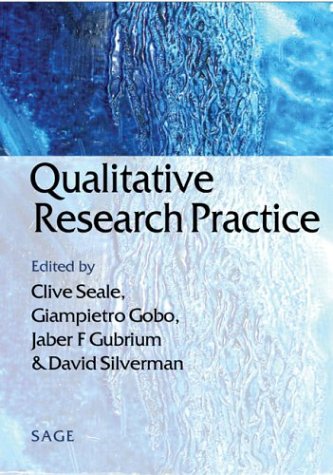Qualitative Research Practice
Seale, Clive, Gobo, Giampietro, Gubrium, Jaber F and Silverman, David
Sage Publications, London
2004
, 0761947760 (hb)
 The last decade has seen an explosion in social science research methods books; note for example the considerable number of research methods textbooks that have been reviewed in Sociological Research Online in its ten years existence.
The last decade has seen an explosion in social science research methods books; note for example the considerable number of research methods textbooks that have been reviewed in Sociological Research Online in its ten years existence.
Seale and colleagues have produced one of the thicker methods books with 620 pages. This edited volume has 38 chapters written by a total of 51 contributors (including the four editors). The book is divided in seven sections starting with 'Encountering Method' and finishing with 'The International Context'. This really is the kind of comprehensive research methods textbook that qualitative researchers and libraries want to have on their shelves.
The book incorporates the kind of standard methods chapters one would expect in any qualitative methods textbook, such as Interviews (Chapter 1 by Rapley), Focus Groups (Chapter 4 by Macnagthen & Myers), Grounded Theory (Chapter 5 by Dey) or Ethical issues (Chapter15 by Ryen). Qualitative Research Practice also offers some more out-of-the-ordinary contributions, such as Teaching Qualitative Method: Craft, Profession, or Bricolage (Chapter 35 by Hammersley), Five Misunderstandings abourt Case-Study Research (Chapter 27 by Flyvbjerg), Secondary Analysis of Archived Data (Chapter 21 by Corti & Thompson) or Publishing Qualitative Manuscripts: Lessons Learned (Chapter 37 by Loseke & Cahill).
One minor criticism is that the two chapters on secondary analysis seem to overlap. Corti and Thompson in Chapter 21 'Secondary Analysis of Archived Data' focus on revisiting data collected by other researchers whilst Chapter 22 by Åkerström and colleagues 'Reanalysis of Previously Collected Material makes the same kind of arguments on re-using one's own data. Perhaps the editors could have been a bit more directive to the contributors to help limit duplication.
It is impossible to highlight the complete range of qualitative research covered in Qualitative Research Practice, but I would like to highlight one chapter because it is different. The final chapter The Globalization of Qualitative Research (Chapter 38 by Alsuutari) argues that, irrespective of where one lives and does research, to an ever greater degree we share the same theories, methods and ideas about how to do qualitative research and how to make sense of human phenomena on the basis of empirical qualitative data (p.595). This chapter addresses the domination of the social science publishing by (1) the English language; and (2) the US and UK markets. Alsuutari uses the example of his own development as a qualitative researcher in Finland as an example of how one becomes a qualitative researcher (pp.604-5). This autobiographical sections did not fit in well, as it was too focused on individual detail and not enough on globalization of qualitative research which was the aim of the chapter.
Apart from the book's editors and book reviewers very few will read Qualitative Research Practice cover to cover. Therefore, slight differences in writing styles between the chapters are not important, and will go largely unnoticed. The researcher opening the book on focus groups is unlikely to read the chapter on oral history next. Equally readers at different stages in their research careers will focus on different chapters, thus a postgraduate sociology student is perhaps unlikely to read Writing a Social Science Monograph (Chapter 36 by Czarniawska). As readers are likely to dip into certain chapters/topics an extensive index is needed. Qualitative Research Practice offers eleven and a half pages of indexed words and terms.
This book is in the first place a library book, providing an overview of different aspects of qualitative research. It is also a very useful book for people teaching qualitative research methods, especially as very few of us have hands-on experience in conducting research using whole range of qualitative research methods. Many academic researchers will have their favourite qualitative method(s) in which they have a lot of experience and a few less favourite qualitative methods in which they have limited experience. Qualitative Research Practice offers insight into the methods in which we do not have extensive experience. Finally, it is also good textbook to give to postgraduate students who have not yet made up their mind about their research project or dissertation, and who need some more insight into the strengths and weaknesses of those qualitative methods which are most useful/suitable for their study.
Edwin van Teijlingen
Medical School, University of Aberdeen

